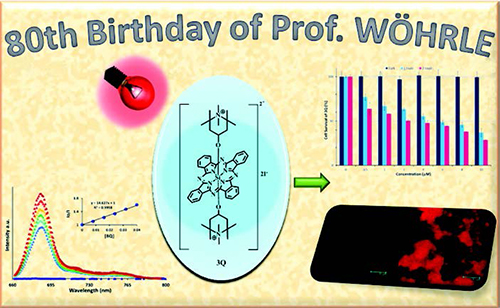Журнал "Макрогетероциклы"
Navigation
News
Impact Factor 2021 = 1.200 has been issued by ISI Web of Knowledge (JCR 2021).
Search
ISSN 1998-9539
Novel Water-Soluble Silicon(IV) Phthalocyanine for Photodynamic Therapy and Antimicrobial Inactivations
İpek Ömeroğlu,a Meltem Göksel,a,b Vesselin Kussovski,c Vanya Mantareva,d@1 and Mahmut Durmuşa@2
Dedicated to Professor Dieter Wöhrle on the occasion of his 80th Anniversary
aGebze Technical University, Department of Chemistry, 41400 Gebze, Kocaeli, Turkey
bKocaeli University, Kosekoy Vocational School, 41135 Kartepe, Kocaeli, Turkey
cThe Stephan Angeloff Institute of Microbiology, Bulgarian Academy of Sciences, 1113 Sofia, Bulgaria
dInstitute of Organic Chemistry with Centre of Phytochemistry, Bulgarian Academy of Sciences, 1113 Sofia, Bulgaria
@1Corresponding author E-mail: mantareva@orgchm.bas.bg
@2Corresponding author E-mail: durmus@gtu.edu.tr
DOI: 10.6060/mhc190763m
Macroheterocycles 2019 12(3) 255-263
The synthesis and characterization of axially bis(1,2,2,6,6-pentamethyl-4-piperidinol) silicon(IV) phthalocyanine (3) and its water-soluble cationic derivative (3Q) were defined in this study. Both newly synthesized silicon(IV) phthalocyanines were characterized by FT-IR, UV-Vis, 1H NMR, MALDI-TOF and elemental analysis as well. Although the photophysical and photochemical properties of newly synthesized axially bis(1,2,2,6,6-pentamethyl-4-piperidinol) silicon(IV) phthalocyanine was investigated in DMSO, its water-soluble derivative was investigated in both DMSO and phosphate buffer saline (PBS). The fluorescence quenching behavior of the studied water-soluble silicon(IV) phthalocyanine (3Q) by the addition of 1,4-benzoquinone (BQ) was also described in DMSO. Besides, the binding behavior of 3Q, it was examined by bovine serum albumin (BSA) protein in PBS for determination of transportation abilities of this phthalocyanine in the blood. Photodynamic activity of water-soluble silicon(IV) phthalocyanine (3Q) was tested in vitro on tumor cells and for inactivation of bacterial pathogens with promising photocytotoxicity for both PDT applications.

| Attachment | Size |
|---|---|
| mhc190763m.pdf | 3.73 MB |
- 1473 reads
- Русский
